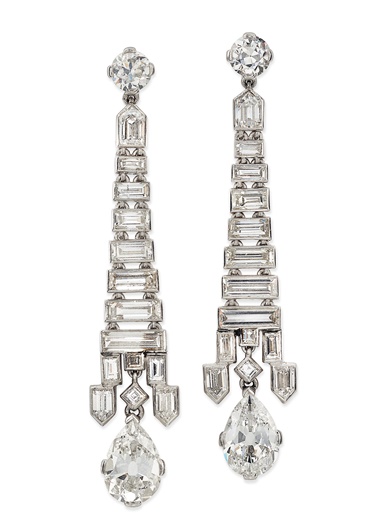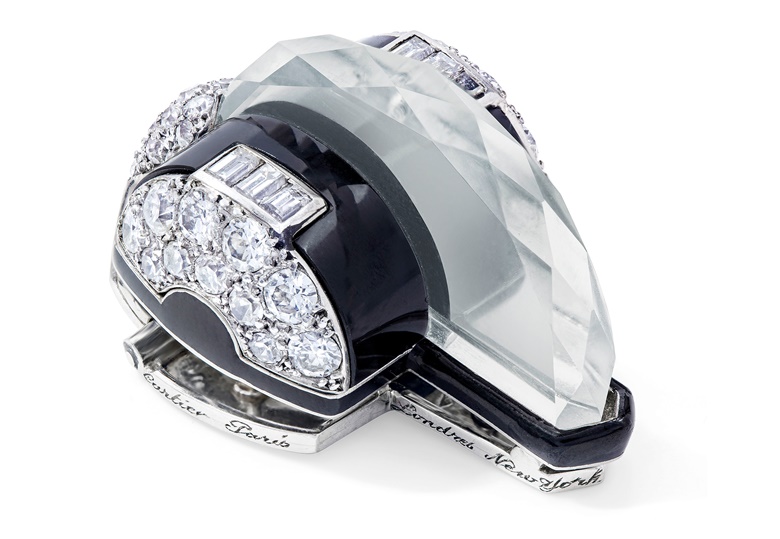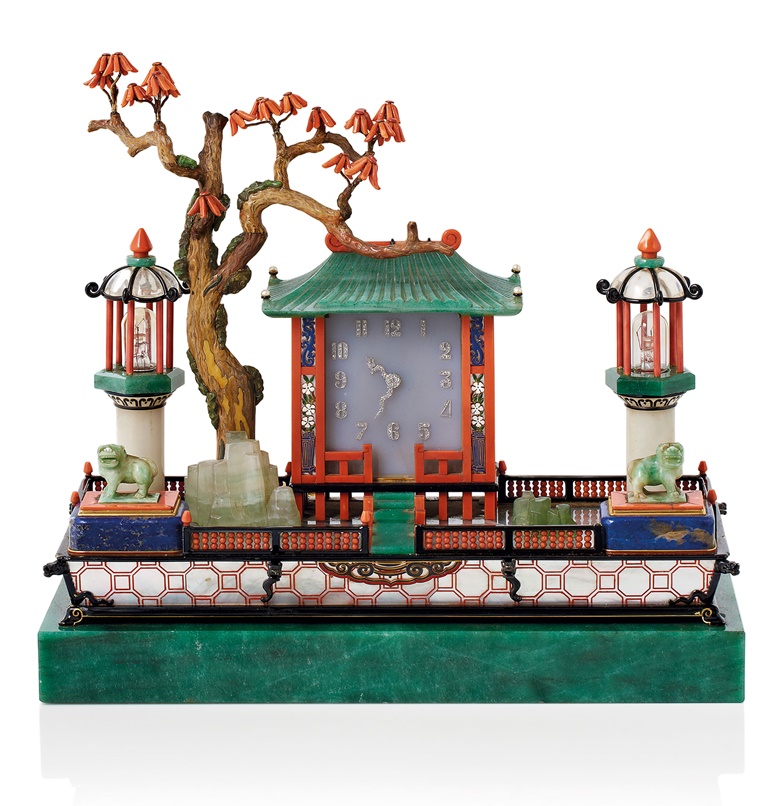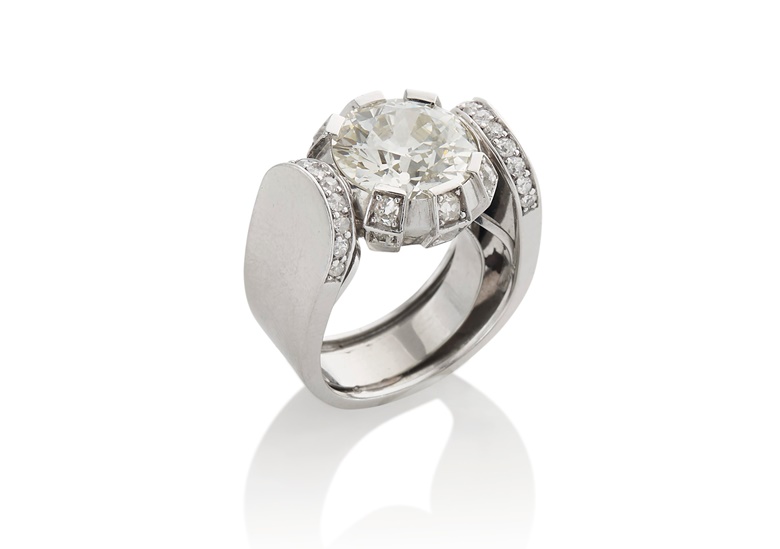An expert introduction to the jewellers who cast aside the naturalistic forms of Art Nouveau in favour of the clean lines of modernity. Illustrated with pieces offered at Christie’s
The end of the First World War heralded a revolt against the excesses of the Edwardian and Belle Epoque eras. The Great War had ravaged European cultural centres, women had stepped in to fill industrial roles left vacant by men called to the Front, and the wealth of the nobility had been severely dented. In this rapidly changing environment, the Art Deco design movement emerged.
First exhibited in Paris in 1925, at the Exposition Internationale des Arts Décoratifs et Industriels Modernes (although some date the style to as far back as 1915), Art Deco was the visual embodiment of modernist principles. Celebrating the triumph of technology and the sleek, liberating forms of the machine age, its emphasis on structure responded to a widespread desire for order in the wake of chaos.
.jpg?mode=max&width=1025?w=380)
.jpg?mode=max&width=1025?w=380)
Until 1935 — and in ways that continued to influence design through the 1940s — master jewellers such as Cartier, Van Cleef & Arpels, Maison Janesich, Ostertag, René Boivin, Paul Brandt, Raymond Templier and Fouquet innovated alongside artists and architects to develop the relationship between form and function. Sweeping, fluid lines and nature-based motifs gave way to geometric design as clean lines, contrast and colour came into vogue.


New materials and combinations
The Art Deco movement ‘cast aside the dictats of the past’, says decorative arts historian Melissa Gabardi. Art Deco jewels were sleek and bold, characterised by sharp edges and regularity of surface, line and volume. Unorthodox combinations of stones were introduced, with many designs combining natural materials such as onyx, emeralds, rubies, jade, silver, ivory, lapis and rock crystal with manufactured ones such as plastic and glass.
.jpg?mode=max&width=1025?w=780)
‘While designers came from diverse backgrounds, they all held the same ideal: to make a clean break from the past, draw inspiration from everyday life, and rid the decorative arts of useless ornamentation,’ says Laurence Mouillefarine, a historian of the Art Deco period.
As women’s clothes became streamlined, so did jewellery
Art Deco forms weren’t necessarily simpler, but rather became more linear and streamlined; large gemstones were rejected in favour of small, brilliant-cut diamonds.
.jpg?mode=max&width=1025?w=780)
This freer sensibility reflected similar changes in women’s fashion, such as the androgynous silhouettes designed by the likes of Paul Poiret and Coco Chanel which liberated women’s ability to move.
.jpg?w=780)
Later in the Art Deco period, when women’s fashions acquired a more structural component, clips and double-clip brooches became popular.
.jpg?mode=max&width=1025?w=780)
Contrast, colour, and crystal
As Art Deco jewellery designers emphasised geometry in their designs, contrasts in colour were also accentuated.

Designers also frequently placed rock crystal alongside diamonds. Whether clear, carved, or frosted, the contrast of the crystal heightened a diamond’s brightness while working within the same colour palette.
.jpg?w=780)
Exotic inspirations
In the early 20th century a renewed interest in Egyptian, Chinese and Japanese art offered European artists a new source of stylistic motifs. They adapted decorative elements particular to Asian jewellery, such as jade, coral, enamels, lacquer and pearls. Designs ranged from exact copies of dragons, pagodas and Chinese characters, to more liberal interpretations of Asian themes.

Designers borrowed plant and flower motifs from Persian carpets and miniatures, as well as refining the delicate range of roses, daffodils and cherries, or the bold combination of certain colours such as blue and green (emerald and sapphire or lapis and jade).
Look for vanity cases and smoking accessories, too
Many Art Deco jewellers produced lacquered silver boxes, smoking accessories or beauty cases. Some of the best among these are pieces by the Parisian jeweller Templier, whose ‘imagination was freed by city life, new techniques and technologies, advancements in transportation,’ says Mouillefarine. Other exquisite examples were produced by Van Cleef & Arpels, Cartier and Paul Brandt.
.jpg?mode=max&width=1025?w=780)
The most important houses
Cartier: Louis-François Cartier founded his company in 1847 in Paris. His three grandsons, Louis, Pierre and Jacques, turned the House into a global enterprise, with Louis running Paris, Jacques overseeing London and Pierre managing New York.
The years 1910-1940 are considered by many experts to be the golden era for Cartier. It employed the finest designers and craftsmen, and with royalty, film stars and business tycoons among its clientele, there were few limits to its creative ambitions.
.jpg?mode=max&width=1025?w=780)
After the First World War Cartier was at the forefront of Art Deco innovation, introducing the Tank watch in 1917 and ‘Tutti Frutti’ jewellery — inspired by India — that became very popular in the 1920s.
Van Cleef & Arpels: The house of Van Cleef & Arpels was the result of the marriage between Alfred Van Cleef and Estelle Arpels. In 1906, Alfred founded Van Cleef & Arpels with Estelle’s brother Charles at 22 place Vendôme, soon joined by family members Julien and Louis Arpels.
Renée Puissant, daughter of Alfred and Estelle, formed a design team with René Sim Lacaze, and produced jewels for the firm for two decades. The 1930s was a golden period for expansion and for creativity: the house’s signature Mystery setting, the Minaudière vanity case the Passe Partout line were all created during this time.
.jpg?w=780)
Janesich: Leopoldo Janesich opened his first shop in Trieste in 1835, offering jewellery and silverware to an international clientele. At the end of the century, he established a branch store in Paris at 19, rue de la Paix, followed by locations in Biarritz, London, Monte Carlo and Vichy.
Janesich’s clients included such eminent personalities as the Archduke of Austria, King Nicholas of Montenegro and the Duke of Aosta. Janesich is well known for powder compacts and card cases in the Art Deco style. The firm remained in family hands until it closed in 1968.
Raymond Templier: Masion Templier was founded by Charles Templier, who opened a jewellery shop in Paris in 1849. His son, Paul, succeeded him, and the company flourished under his direction. ‘Raymond [Templier] joined the family jewellery business after he had graduated from the École Nationale Supérieure des Arts Décoratifs,’ explains Laurence Mouillefarine.
‘He was the artist of the family. He was a perfectionist and demanding when it came to manufacturing. His jewellery pieces are flawlessly crafted, impeccable. Authentic pieces are readily identifiable because of this.’
.jpg?w=780)
Fouquet: Georges Fouquet was open to innovation,’ says Mouillefarine. ‘In 1925, he was president of the jewellery section at the International Exhibition of Modern Decorative and Industrial Arts in Paris. The event only accepted “works of new inspiration”. His son, Jean, had joined the company’s design team in 1919, when he was 20, and the designs he dreamt up for the family business were masterful — sometimes inspired by mechanics, sometimes exquisitely precious.
After 1936, when the Fouquet jewellery house closed, Jean continued to make jewellery, exhibiting it in Parisian salons and galleries in the company of other designers.’ The emerald, onyx and diamond pendant necklace below was specifically created for the 1925 International Exhibition from which Art Deco took its name, thus making it quintessentially Art Deco.
.jpg?w=780)
Ostertag: Founded in the 1920s by Arnold Ostertag and sited in place Vendôme in Paris — along with all the other important jewellery houses of the period — Ostertag’s creations of the 1920s and 1930s rivalled those of Cartier, Van Cleef & Arpels or Boucheron.
Perhaps best known for his jewellery and objets d’art based on Indian designs, Ostertag also retailed high-quality jewelled watches supplied by Audemars Piguet, and wonderful clocks created by the famous clockmaker George Verger. Ostertag closed its doors with the outbreak of the Second World War, and did not reopen in 1945.
René Boivin: ‘When René Boivin was starting his company, he wanted to create a business that united different talents, and he succeeded,’ says Françoise Cailles, the author of a book on the house.
‘Few customers really understood his avant-garde jewellery. Boivin has always created jewellery for a select few, for an intellectual and artistic elite. When he died in 1917, his wife Jeanne took the reins of the firm. Their daughter Germaine would also join the company later. Boivin was always rowing against the current of the day, whether it was Art Nouveau or Art Deco.’

Paul Brandt: A talented Swiss jeweller, painter, sculptor and engraver, Paul Brandt settled in Paris, where he was already designing jewellery during the Art Nouveau period. He first came to public attention with his Art Deco jewellery at the 1925 World Fair, becoming more famous in the 1930s thanks to his extremely modernist work. The beauty of his abstract, geometric jewellery lies in its discrete linear harmony and immaculate execution.









